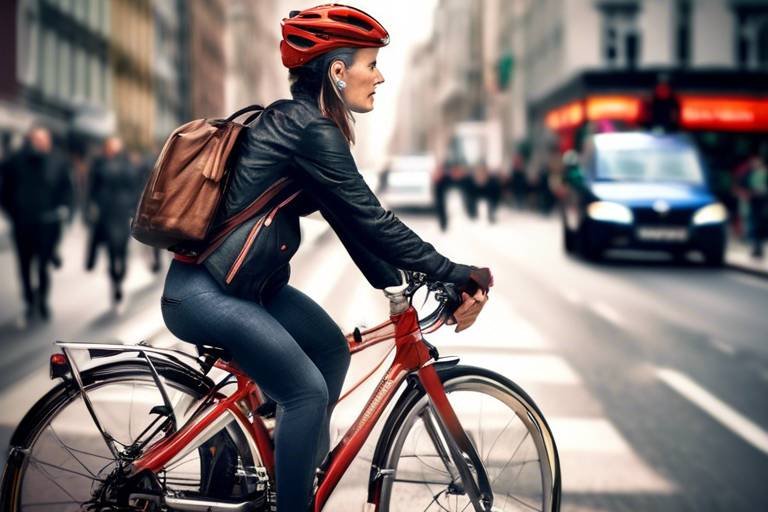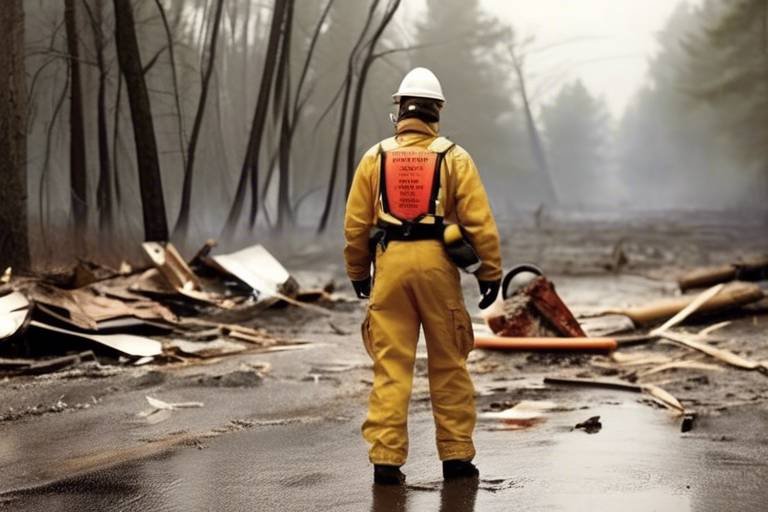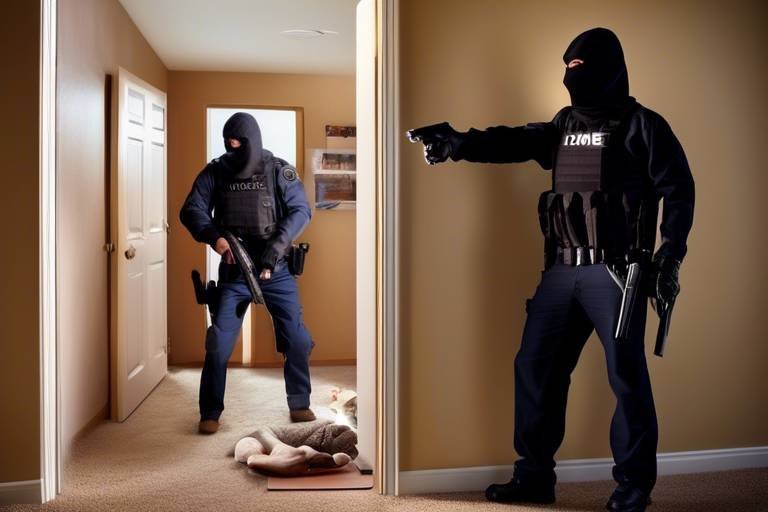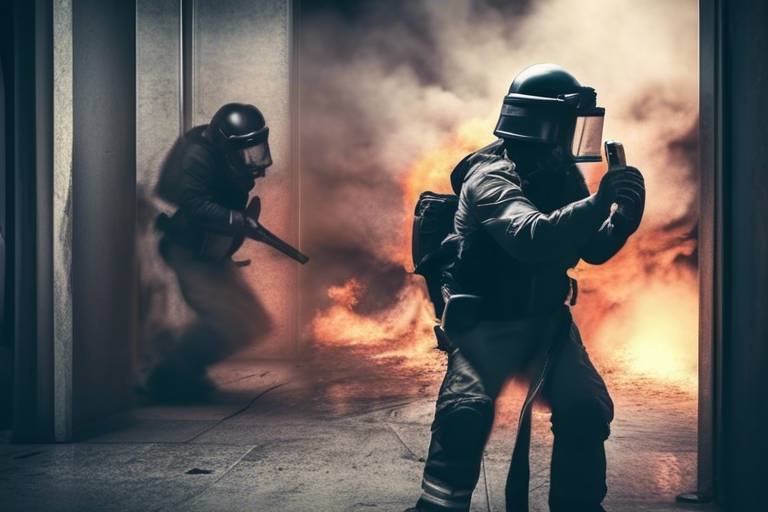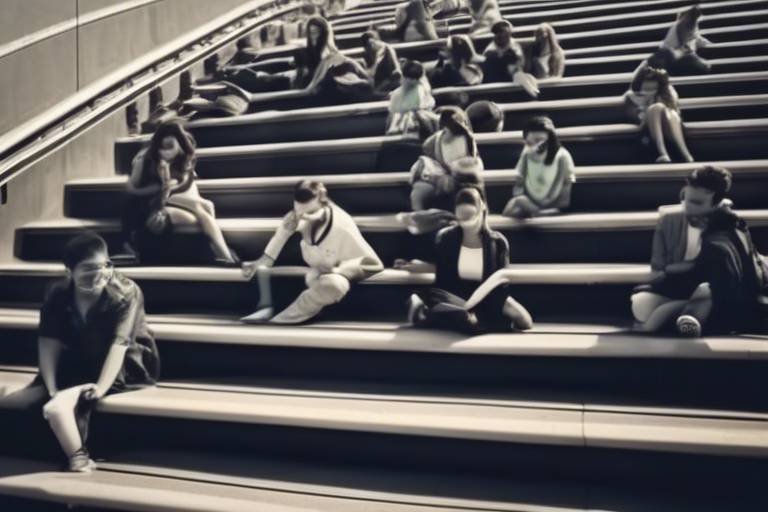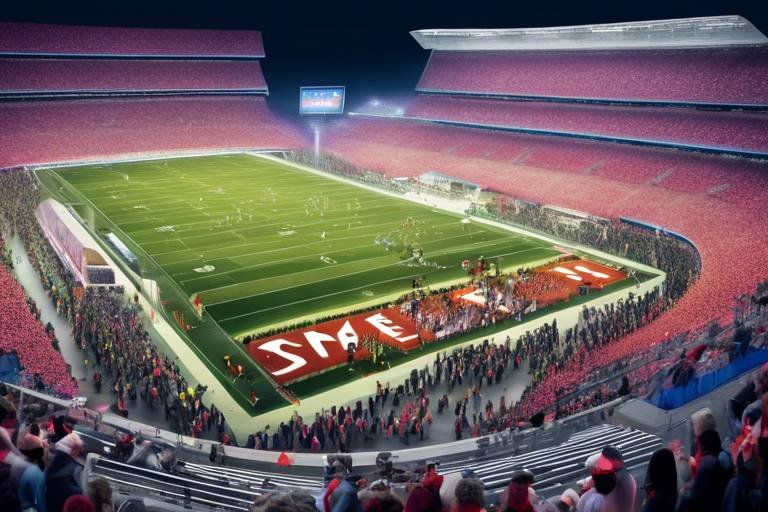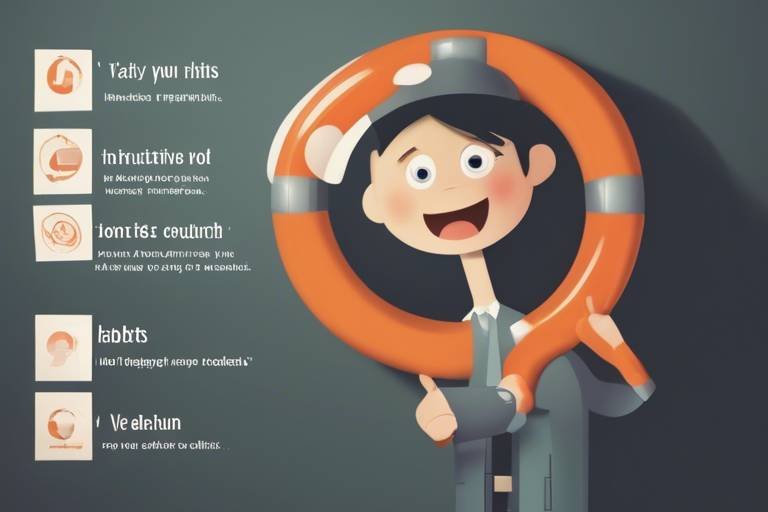How to Stay Safe While Cycling in the City?
Cycling in the city can be both exhilarating and intimidating. Imagine zipping past traffic, feeling the wind in your hair, and enjoying the freedom that comes with two wheels. But hold on a second! Before you embark on your urban cycling adventure, it's crucial to arm yourself with the right knowledge and strategies to ensure your safety. This article dives into essential safety tips and strategies for urban cyclists, helping you navigate the bustling streets with confidence and ease.
Urban environments are bustling with activity, and understanding the dynamics of city traffic is the first step towards safe cycling. From impatient drivers to distracted pedestrians, the city presents numerous challenges. You might wonder, how do I anticipate the behavior of those around me? Well, it’s all about being observant and proactive. Pay attention to the flow of traffic, watch for sudden stops, and be prepared for unexpected movements from both vehicles and pedestrians. Remember, the city is alive, and being aware of your surroundings is key to avoiding potential hazards.
Now, let’s talk about gear. Having the right cycling equipment can make a world of difference in your safety. A good helmet, bright lights, and reflective clothing are not just accessories; they are your best friends on the road. Think of your helmet as your personal guardian angel. It’s there to protect you from serious injuries in case of an accident. But not all helmets are created equal! You need to choose one that fits well and meets safety standards. This leads us to an important point: maintaining your helmet and knowing when to replace it can save your life. A helmet that has seen better days is not going to protect you effectively.
Navigating city traffic can be daunting for cyclists. The streets are often filled with a mix of cars, buses, and pedestrians, each with their own agenda. As a cyclist, it’s crucial to anticipate the behavior of these road users. For instance, did you know that many accidents occur when cyclists and drivers are not aware of each other’s movements? By staying alert and understanding traffic patterns, you can significantly reduce your risk of accidents. Make it a habit to scan the road ahead, looking for potential hazards like parked cars or pedestrians stepping out unexpectedly.
When it comes to cycling safety, the right gear is your first line of defense. Let’s break down the essentials:
- Helmets: A must-have for every cyclist, a well-fitted helmet can save your life.
- Lights: Front and rear lights are crucial, especially during low-light conditions.
- Reflective Clothing: Wearing bright or reflective gear makes you more visible to drivers.
Investing in quality gear not only enhances your safety but also boosts your confidence on the road. Remember, being visible is key to cycling safety!
A well-fitted helmet can save lives. When selecting a helmet, consider factors like safety ratings, comfort, and fit. A helmet that’s too loose or too tight won’t provide the protection you need. Look for options with adjustable straps and adequate ventilation to keep you comfortable during long rides. And don’t forget to check for safety certifications!
Maintaining your helmet is essential for safety. Here are some tips to ensure your helmet remains effective:
- Inspect your helmet regularly for cracks or damage.
- Clean it with mild soap and water, avoiding harsh chemicals.
- Store it in a cool, dry place to prevent deterioration.
Knowing when to replace your helmet is critical. If you've been in a crash, even if there are no visible signs of damage, it’s best to replace it. Additionally, if your helmet is over five years old, consider investing in a new one, as materials can degrade over time.
Being visible is key to cycling safety. Using lights and wearing reflective gear, especially during low-light conditions, can significantly enhance your presence on the road. A bright front light and a flashing rear light can make you stand out, even in the darkest of environments. Think of it like a lighthouse guiding ships; your lights are your beacon, helping motorists see you from a distance.
Practicing road awareness is vital for cyclist safety. Always be vigilant and anticipate potential dangers. This means keeping an eye on parked cars for opening doors, watching for pedestrians at crosswalks, and being aware of cyclists around you. Defensive riding techniques, such as maintaining a safe distance from vehicles and using hand signals, can help you avoid accidents.
Traffic signals play a crucial role in cycling safety. As a cyclist, it’s essential to interpret and respond to these signals correctly. Always stop at red lights, yield to pedestrians, and be aware of turning vehicles. Following traffic signals not only keeps you safe but also promotes a positive relationship with other road users.
Effective communication with drivers can prevent accidents. Use hand signals to indicate your intentions, such as turning or stopping. Making eye contact with drivers can also help ensure they see you. Remember, you’re not just sharing the road; you’re part of a larger traffic ecosystem.
Selecting safe cycling routes is essential for avoiding hazards. Look for bike-friendly paths and roads that minimize risks. Apps and local cycling maps can help you identify the best routes. Planning your journey can make a significant difference in your overall experience.
Bike lanes provide a safer space for cyclists. When using bike lanes, stay within the designated area, and be aware of pedestrians and other cyclists. Always signal your movements, and be cautious of vehicles entering or exiting driveways.
Staying away from high-traffic areas can enhance safety. If possible, plan your routes to avoid congested streets. Look for parks or quieter neighborhoods that offer a more relaxed cycling experience.
Q: What should I do if I get into an accident while cycling?
A: First, ensure your safety and the safety of others. Call for medical assistance if needed, and document the scene with photos and witness information.
Q: How can I improve my cycling skills?
A: Consider taking a cycling safety course or joining a local cycling group. Practice regularly and challenge yourself with different terrains.
Q: Are there any laws I should be aware of as a cyclist?
A: Yes, familiarize yourself with local cycling laws, such as helmet requirements, riding on sidewalks, and obeying traffic signals.

Understanding Urban Traffic
Navigating city traffic can be a daunting experience for cyclists, often resembling a high-stakes game where the stakes are your safety and well-being. With a blend of vehicles, pedestrians, and unpredictable road conditions, urban cycling can feel like riding through a jungle of metal and concrete. It's essential to grasp the dynamics of urban traffic to ensure a safe and enjoyable ride. Understanding how different elements interact on the road will empower you to make informed decisions while cycling.
One of the most significant challenges urban cyclists face is the behavior of drivers and pedestrians. Vehicles tend to move quickly and may not always be aware of cyclists sharing the road. This is where anticipation becomes your best friend. By observing traffic patterns, you can predict when a driver might make a sudden turn or when a pedestrian might step off the curb unexpectedly. For instance, watch for:
- Cars waiting at intersections that might suddenly pull out.
- Pedestrians looking at their phones who may not see you approaching.
- Delivery trucks that might block bike lanes or sidewalks.
Moreover, the layout of urban streets can present unique hazards. Potholes, debris, and poorly maintained roads can be lurking around every corner. It's crucial to develop a keen eye for spotting these dangers early. Consider the following:
- Stay alert for potholes or cracks in the pavement that could throw you off balance.
- Watch out for parked cars that may suddenly open their doors.
- Be mindful of construction zones where the road may change unexpectedly.
Another vital aspect of urban traffic is the interaction between cyclists and public transportation. Buses and trams can be frequent and unpredictable, often stopping suddenly or changing lanes without warning. Always keep a safe distance from these vehicles, and be prepared to yield when necessary. Remember, your safety is more important than making a quick pass!
Furthermore, understanding traffic signals is crucial for urban cyclists. These signals are not just for cars; they guide cyclists as well. Familiarize yourself with the rules governing bike lanes and how they intersect with vehicle traffic. For example, in many cities, cyclists are permitted to turn right on red, but only after coming to a complete stop and ensuring the way is clear. Knowing these rules can help you navigate intersections safely and confidently.
Lastly, it’s essential to remain calm and composed amidst the hustle and bustle of city traffic. Panic can lead to poor decision-making, which increases the risk of accidents. Take a deep breath, stay focused, and remember that every ride is an opportunity to improve your skills and confidence as a cyclist. By understanding the complexities of urban traffic and preparing for the challenges ahead, you can transform your cycling experience from stressful to enjoyable.
Q: What should I do if a driver cuts me off?
A: Stay calm, maintain control of your bike, and avoid aggressive reactions. It's essential to prioritize your safety and avoid confrontation.
Q: How can I improve my visibility while cycling?
A: Use bright clothing, reflective gear, and ensure your bike is equipped with lights, especially when riding at night or in low-light conditions.
Q: What are the best routes to take in the city?
A: Look for dedicated bike lanes, paths, and quieter streets that minimize interaction with heavy traffic.

Essential Cycling Gear
When it comes to cycling in the city, having the right gear is not just about comfort; it’s a matter of safety. Imagine riding through bustling streets, dodging cars, and navigating pedestrians. The right cycling gear can make all the difference between a smooth ride and a dangerous encounter. First and foremost, let’s talk about helmets. A good helmet is your best friend when it comes to protecting your noggin. It’s not just a fashion accessory; it’s a critical piece of equipment that can save your life in the event of a fall or collision. But not all helmets are created equal. You want to choose one that fits snugly, has a good safety rating, and feels comfortable on your head.
Besides helmets, visibility is key. You want to be seen, especially during those early morning or late evening rides when the sun is setting. This is where lights and reflective clothing come into play. A bright front light can illuminate your path, while a rear light ensures that drivers can see you from behind. Reflective gear, like vests or ankle bands, can also enhance your visibility significantly. It’s like wearing a neon sign that says, “Hey, I’m here!”
Now, let’s not forget about other essential accessories that can enhance your cycling experience. A sturdy lock is crucial for securing your bike when you stop, and a comfortable saddle can make long rides much more enjoyable. Additionally, consider investing in padded cycling shorts. They may look funny, but trust me, your behind will thank you after a long ride!
Here’s a quick rundown of essential cycling gear:
- Helmet: Ensure it fits well and meets safety standards.
- Lights: Front and rear lights for visibility.
- Reflective Clothing: Helps you stand out in low-light conditions.
- Lock: A good quality lock to keep your bike safe.
- Saddle: A comfortable seat can make all the difference.
- Padded Cycling Shorts: For added comfort on longer rides.
In summary, investing in essential cycling gear is crucial for a safe and enjoyable ride. Think of it as your armor against the unpredictable nature of urban cycling. Just like a knight wouldn’t go into battle without their armor, you shouldn’t hit the streets without the appropriate gear. So, gear up, stay safe, and enjoy the ride!

Choosing the Right Helmet
When it comes to cycling, your helmet is your best friend. It's not just a piece of gear; it’s your first line of defense against potential head injuries. But how do you choose the right one? It’s essential to consider a few key factors to ensure that your helmet not only fits well but also provides the maximum level of protection.
First and foremost, look for a helmet that meets the safety standards set by organizations like the Consumer Product Safety Commission (CPSC) in the United States or the European Committee for Standardization (CE) in Europe. These certifications ensure that the helmet has undergone rigorous testing and can withstand impacts. When you see these labels, you can ride with confidence knowing your helmet has been vetted for safety.
Next, think about the fit. A helmet should sit level on your head and not tilt back or forward. You should be able to fit two fingers between your eyebrows and the front of the helmet. The straps should form a V shape under your ears, and you should be able to adjust the chin strap so that it’s snug but comfortable. Remember, a helmet that doesn’t fit well is as good as no helmet at all!
Another aspect to consider is the weight of the helmet. Lightweight helmets are often more comfortable for long rides, but make sure that the weight doesn’t compromise the protective features. You might also want to look for additional features such as ventilation holes to keep your head cool and a visor to shield your eyes from the sun. Some helmets even come with built-in lights or reflective materials for added visibility during night rides.
Finally, don’t forget about style! With so many designs available, you can find a helmet that suits your personality. Whether you prefer a sleek, minimalist design or something more colorful and bold, there’s a helmet out there for everyone.
To summarize, here are the key points to consider when choosing a helmet:
- Look for safety certifications (CPSC, CE).
- Ensure a proper fit—level on the head, snug straps.
- Consider weight and ventilation for comfort.
- Check for additional features like visors and lights.
- Choose a design that reflects your style.
Investing time in selecting the right helmet can make a world of difference in your cycling experience. Remember, it’s not just about looking cool; it’s about staying safe and protected while enjoying your ride through the bustling city streets.
- How often should I replace my helmet? It’s recommended to replace your helmet every 3-5 years or immediately after a crash.
- Can I wear a used helmet? It’s best to avoid used helmets unless you know their history. They may have hidden damage.
- Are more expensive helmets worth it? Often, yes! Higher-priced helmets may offer better materials, lighter weight, and advanced safety features.

Helmet Maintenance Tips
Taking care of your helmet is just as important as wearing it. Think of your helmet as a trusty shield, protecting you from potential impacts and ensuring your safety on the road. To keep it in top shape, regular maintenance is key. Start by giving your helmet a thorough inspection before each ride. Look for any visible cracks or dents that could compromise its integrity. If you notice any damage, it’s time to say goodbye and invest in a new one.
Cleaning your helmet is another crucial aspect of maintenance. After all, you wouldn’t wear dirty clothes, right? Use a mild soap and warm water to wipe down the exterior. Avoid harsh chemicals that could degrade the materials. For the interior padding, remove it if possible and wash it separately according to the manufacturer’s instructions. This not only keeps your helmet looking fresh but also helps eliminate odors that can build up over time.
Another tip to extend the life of your helmet is to store it properly. When you’re not using it, keep your helmet in a cool, dry place. Avoid leaving it in direct sunlight or in hot areas, like your car, as extreme temperatures can weaken the materials. If you have a helmet bag, use it! This protects your helmet from scratches and impacts when it’s not on your head.
Lastly, remember that helmets have a lifespan. Most manufacturers recommend replacing your helmet every 3 to 5 years, even if it looks fine. This is because the materials can degrade over time, reducing their effectiveness. If you’ve been in a crash, even a minor one, it’s wise to replace your helmet immediately. Your safety is worth the investment!
- How often should I clean my helmet? It's a good practice to clean your helmet after every few rides, especially if you ride in wet or muddy conditions.
- Can I use any soap to clean my helmet? No, avoid harsh chemicals and stick to mild soap and warm water to prevent damaging the helmet’s materials.
- What should I do if my helmet has been in a crash? Replace it immediately, even if you don’t see visible damage. The impact could compromise its protective capabilities.
- Is it necessary to replace my helmet after a certain period? Yes, most helmets should be replaced every 3 to 5 years to ensure maximum safety.

When to Replace Your Helmet
Knowing when to replace your helmet is absolutely critical for your safety as a cyclist. Helmets are designed to protect your head in the event of an accident, but they can only do their job effectively if they are in good condition. Over time, helmets can suffer from wear and tear that diminishes their protective capabilities. So, how do you know when it's time to say goodbye to your trusty helmet and invest in a new one?
First and foremost, if your helmet has been involved in a crash, it’s time to replace it. Even if it looks fine on the outside, the internal structure may be compromised. The foam inside a helmet is designed to absorb impact, and once it has done its job, it cannot be relied upon again. Think of it like a sponge that has soaked up water; it just won’t function the same way after that!
Additionally, pay attention to the age of your helmet. Most manufacturers recommend replacing your helmet every 3 to 5 years, even if it hasn’t been in any accidents. Over time, the materials can degrade due to exposure to sunlight, sweat, and general wear. If you’re unsure about the age of your helmet, check for a manufacturing date, which is often found inside the helmet itself. If it’s older than five years, it might be time to start shopping.
Another indicator that it’s time for a new helmet is visible damage. Cracks, dents, or any deformation of the helmet's structure are clear signs that it can no longer provide the level of protection you need. Even minor scratches can indicate that the integrity of the helmet has been compromised. If you notice any of these signs, don’t hesitate to replace it.
Lastly, consider the fit and comfort of your helmet. As you ride more frequently, your head shape may change, or the padding may wear down, leading to an uncomfortable fit. A helmet that doesn’t fit properly can be just as dangerous as a damaged one, as it may not stay in place during a fall. If you find yourself constantly adjusting your helmet or it feels loose, it’s a good idea to look for a new one.
In summary, here are the key factors to consider when deciding to replace your helmet:
- Involvement in a crash: Replace immediately.
- Age: Generally every 3 to 5 years.
- Visible damage: Cracks, dents, or deformities.
- Poor fit: If it feels uncomfortable or loose.
Remember, investing in a new helmet is not just about following guidelines; it’s about ensuring your safety on the road. A good helmet can be the difference between a minor incident and a life-altering accident. So, don’t take chances—stay safe and keep your helmet in top shape!
Q: How often should I replace my helmet?
A: It’s recommended to replace your helmet every 3 to 5 years, even if it hasn’t been in an accident.
Q: What should I do if my helmet has been in an accident?
A: If your helmet has been involved in a crash, replace it immediately, regardless of visible damage.
Q: Can I repair my helmet?
A: No, helmets are designed to absorb impact once. If damaged, they should be replaced rather than repaired.
Q: How can I tell if my helmet is too old?
A: Check the manufacturing date inside the helmet. If it’s older than five years, it’s time for a new one.

Visibility and Lighting
When it comes to cycling in the city, visibility is your best friend. Imagine yourself pedaling through bustling streets, surrounded by a sea of cars, buses, and pedestrians. The last thing you want is to blend into the background! That's why investing in proper lighting and wearing reflective gear are non-negotiable. They not only enhance your visibility but also significantly reduce the risk of accidents, especially during those dusky hours when the sun dips below the horizon.
First off, let's talk about lights. A good set of front and rear lights can make a world of difference. You want your front light to be bright enough to illuminate the path ahead, allowing you to see any potential hazards. A minimum of 200 lumens for the front light is recommended, while the rear light should be equally bright to catch the attention of drivers behind you. Not only does this help you see, but it also ensures that others can see you. Consider investing in lights with different flashing modes; they can be more eye-catching compared to steady lights.
Reflective clothing is another crucial element. Wearing a high-visibility vest or jacket can literally make you stand out like a neon sign. But it doesn’t stop there; you can also enhance your visibility by using reflective tape on your bike and gear. Even your helmet can be adorned with reflective stickers. The goal is to create a 360-degree visibility effect, so you’re not just a shadow whizzing by. Remember, the more visible you are, the safer you are!
Now, let’s not forget about the importance of positioning your lights correctly. Your front light should be mounted at a height that allows it to shine straight ahead without blinding oncoming traffic. Ideally, it should be about three feet off the ground. The rear light should be placed at the back of your bike, easily visible from a distance. Some cyclists even opt for lights that can be attached to their backpacks or helmets for added visibility.
In summary, proper visibility and lighting are not just accessories; they are essential safety features for every urban cyclist. By equipping yourself with the right gear, you not only protect yourself but also contribute to a safer cycling environment for everyone. So, the next time you gear up for a ride, ask yourself: Are you visible enough? If the answer is 'no', it’s time to make some changes!
- How bright should my bike lights be? A front light should ideally have at least 200 lumens, while rear lights should be equally bright for maximum visibility.
- Is reflective gear really necessary? Yes! Reflective gear significantly enhances your visibility, especially in low-light conditions.
- Where should I position my bike lights? The front light should be mounted about three feet off the ground, while the rear light should be at the back of your bike for optimal visibility.
- Can I use regular clothing while cycling? While you can, wearing high-visibility clothing is recommended to ensure you are seen by others on the road.

Road Awareness and Defensive Riding
When it comes to cycling in the bustling chaos of city streets, road awareness and defensive riding become your best allies. Imagine yourself as a skilled chess player, always anticipating your opponent’s next move. In the urban jungle, cyclists must be equally alert, watching for sudden movements from vehicles, pedestrians, and even other cyclists. The key is to stay one step ahead, which means keeping your head on a swivel and your senses sharp. This vigilance not only enhances your safety but also allows you to enjoy the ride without unnecessary stress.
One of the most important aspects of road awareness is understanding the dynamics of traffic. Cars, trucks, and buses can be unpredictable, and their drivers may not always see you. Therefore, it’s essential to anticipate potential hazards. For instance, a driver might suddenly change lanes without signaling, or a pedestrian might step off the curb without looking. By being aware of your surroundings and predicting these actions, you can react swiftly and avoid dangerous situations.
Moreover, adopting a defensive riding posture is crucial. This means not just riding your bike, but actively defending your space on the road. Here are a few tips to enhance your defensive riding skills:
- Maintain a Safe Distance: Always keep a safe distance from vehicles, especially those that are larger or appear to be turning. This gives you ample time to react if they make an unexpected move.
- Use Your Voice: Don’t hesitate to call out or ring your bell if you need to alert a driver or pedestrian of your presence. A simple “on your left” can go a long way in preventing accidents.
- Position Yourself Wisely: Ride in a position that maximizes your visibility. This often means taking the lane when necessary, especially at intersections.
Another critical aspect of defensive riding is understanding and obeying traffic signals. As a cyclist, you are subject to the same rules of the road as motor vehicles. This means stopping at red lights and yielding to pedestrians at crosswalks. By following these rules, you not only protect yourself but also set a positive example for others on the road.
Effective communication with drivers is also a vital component of defensive riding. Hand signals are your friend! They are a simple yet effective way to indicate your intentions. For instance, extending your left arm straight out signals a left turn, while a right turn can be indicated by raising your right arm. These gestures enhance your visibility and help drivers understand your next move.
In summary, mastering road awareness and defensive riding is essential for any urban cyclist. By staying alert, anticipating potential hazards, and communicating effectively, you can significantly reduce your risk of accidents and enjoy a safer cycling experience. Remember, cycling in the city should be a joy, not a source of anxiety. So gear up, stay aware, and ride confidently!
Here are some common questions cyclists have about road awareness and defensive riding:
- What should I do if a driver cuts me off? Stay calm, maintain control of your bike, and avoid confrontation. Use your bell or voice to alert them to your presence if necessary.
- How can I improve my visibility on the road? Use bright clothing, reflective gear, and lights, especially during low-light conditions. Make sure to position yourself where drivers can see you.
- What are the best hand signals to use? Familiarize yourself with standard hand signals for turning and stopping. Practice them regularly to ensure they become second nature.

Understanding Traffic Signals
When you’re cycling through the bustling streets of a city, traffic signals aren’t just mere suggestions; they are your lifeline. Understanding these signals is crucial for your safety and the safety of others on the road. Imagine navigating a busy intersection without knowing when to stop or go! It can be a recipe for disaster. So, let’s break down the essentials of traffic signals and how they apply to cyclists.
First off, it’s important to recognize the different types of traffic signals you’ll encounter. These include red lights, green lights, and yellow lights. Each one has a specific meaning:
- Red Light: This means stop. As a cyclist, you must come to a complete halt at the stop line. It’s tempting to roll through, especially if the intersection seems clear, but obeying this signal is non-negotiable for your safety.
- Green Light: Go! But remember, just because you have a green light doesn’t mean it’s safe to proceed. Always look out for pedestrians crossing and vehicles that may not yield.
- Yellow Light: This is your warning that the light is about to turn red. If you’re far enough away, it’s best to prepare to stop rather than speed up to beat the light.
In addition to these basic signals, many cities have bicycle-specific signals. These are often illuminated with a bicycle icon and can either be green or red. If you see a green bicycle signal, it means you can proceed safely, but always check for pedestrians and vehicles. A red bicycle signal, on the other hand, means you must stop, just like a red light for cars.
Another critical aspect of understanding traffic signals is knowing how to respond to flashing signals. A flashing red light indicates you must come to a complete stop and proceed only when it is safe to do so, similar to a stop sign. A flashing yellow light, however, is a caution signal, advising you to slow down and be prepared to stop for any potential hazards.
Moreover, being aware of pedestrian signals is equally important. If you see a pedestrian crossing signal, it’s a good reminder to be vigilant, as pedestrians have the right of way. Always be prepared to yield if someone is crossing your path, even if you have a green light.
Finally, let’s not forget about the importance of communication. When approaching an intersection, use hand signals to indicate your intentions to drivers and other cyclists. This not only helps you stay safe but also promotes a culture of awareness on the roads.
In summary, understanding traffic signals is a fundamental skill for any urban cyclist. By respecting these signals and being aware of your surroundings, you can significantly reduce the risk of accidents and enjoy a safer ride through the city.
- What should I do if a traffic signal is malfunctioning? If a traffic signal is out, treat the intersection as a four-way stop. Yield to any vehicles or pedestrians already in the intersection.
- Are bicycle signals mandatory to follow? Yes, bicycle signals are legally binding and must be obeyed just like traffic signals for vehicles.
- Can I ride through a red light if there are no cars around? No, cyclists must stop at red lights. Running a red light can lead to accidents and legal penalties.

Communicating with Drivers
When you're out cycling in the bustling city, one of the most crucial skills you can develop is effective communication with drivers. This isn’t just about shouting or waving your arms wildly; it’s about creating a shared understanding between you and the motorists around you. After all, you’re both trying to navigate the same roads, and a little clarity can go a long way in preventing accidents. So, how do you ensure that your intentions are clear to drivers?
First and foremost, hand signals are your best friend. Just like how a conductor guides an orchestra, you need to guide drivers with clear signals. Here’s a quick rundown of the essential hand signals every cyclist should know:
- Left Turn: Extend your left arm straight out to the side.
- Right Turn: Extend your right arm straight out to the side or bend your left arm upward at a 90-degree angle.
- Stopping: Extend your left arm downward, palm facing back.
Using these signals not only helps in making your intentions known but also fosters a sense of predictability on the road. Drivers appreciate knowing what you plan to do next, and it can significantly reduce the chances of a mishap.
Moreover, maintaining eye contact with drivers can be incredibly beneficial. When you see a vehicle approaching an intersection, try to make eye contact with the driver. This simple act can communicate, “I see you, and I’m aware of your presence.” It’s like a silent agreement that you both acknowledge each other’s position on the road. If a driver looks at you, it’s a good sign that they’re aware of you and are likely to yield or wait for you to pass.
In addition to hand signals and eye contact, don’t underestimate the power of your body language. Your posture on the bike can convey a lot. For instance, if you appear tense and rigid, drivers may perceive you as uncertain or nervous. On the other hand, riding confidently with a relaxed posture can instill trust in drivers, making them more likely to give you space and respect your right of way.
Lastly, it’s essential to be aware of your surroundings and the behavior of drivers. If a driver seems distracted or is not yielding, don’t hesitate to adjust your actions accordingly. Sometimes, it’s better to yield the right of way than to assert it, especially when safety is at stake. Think of it as a dance; sometimes, you lead, and other times, you follow, all while keeping the rhythm of the road in mind.
In conclusion, effective communication with drivers is a vital aspect of urban cycling safety. By using hand signals, making eye contact, and being aware of your body language, you can create a safer environment for yourself and those around you. Remember, it’s not just about being seen; it’s about being understood. So, the next time you’re out on your bike, think of yourself as a conductor leading an orchestra, ensuring that every note is in harmony!
Q: What should I do if a driver doesn't respond to my signals?
A: If a driver doesn’t seem to respond to your signals, it’s best to proceed with caution. Always prioritize your safety and be prepared to adjust your actions if necessary.
Q: Are there any other ways to communicate with drivers?
A: Yes! In addition to hand signals, you can use your bike’s lights and reflectors, especially at night, to enhance your visibility and communicate your presence on the road.
Q: How can I practice these communication techniques?
A: Practicing in low-traffic areas can help you become more comfortable with hand signals and body language. You can also ride with experienced cyclists who can provide feedback.

Choosing Safe Routes
When it comes to cycling in the city, one of the most crucial decisions you can make is . The urban landscape is often a maze of bustling streets, busy intersections, and unpredictable traffic, making it essential to plan your rides thoughtfully. Imagine navigating a jungle where every turn could lead to a new challenge; that’s what city cycling can feel like. By selecting routes that prioritize safety, you can significantly reduce your risk of accidents and enjoy a more relaxed ride.
First and foremost, consider using bike paths and dedicated bike lanes whenever possible. These lanes are designed specifically for cyclists, providing a buffer between you and motor vehicles. Not only do they enhance your safety, but they also allow you to ride with more confidence. Many cities have invested in expanding their cycling infrastructure, so take advantage of these designated areas. You can usually find maps or apps that highlight bike-friendly routes in your city, making it easier to plan your journey.
Another effective strategy is to avoid high-traffic areas. Congested streets can be a cyclist's worst nightmare, filled with impatient drivers and frequent stops. Instead, look for quieter side streets or residential neighborhoods that might take a little longer to navigate but offer a much safer environment. You might be surprised at how much more enjoyable your ride becomes when you’re not dodging cars at every turn. To help you visualize this, here’s a quick comparison:
| Route Type | Safety Level | Traffic Volume |
|---|---|---|
| High-Traffic Areas | Low | High |
| Bike Lanes | High | Medium |
| Residential Streets | High | Low |
Additionally, consider the time of day you are cycling. Rush hours can be particularly chaotic, with drivers eager to get to their destinations. If your schedule allows it, try to ride during off-peak times when traffic is lighter. This not only enhances your safety but also makes for a more pleasant experience as you can enjoy the sights and sounds of the city without the constant stress of navigating through heavy traffic.
Lastly, don’t hesitate to connect with local cycling communities. These groups can be an invaluable resource for sharing tips on safe routes and advising on the best times to ride. Many cities have online forums or social media groups dedicated to cyclists, where you can ask questions and get recommendations from seasoned riders. Think of it as having a map drawn by locals who know the ins and outs of the city’s cycling landscape.
In summary, choosing safe routes while cycling in the city is all about being strategic. By utilizing bike lanes, avoiding high-traffic areas, considering the time of day, and connecting with local cyclists, you can create a safer and more enjoyable riding experience. Remember, your safety is in your hands, and with a little planning, you can navigate the urban jungle with ease.
- What are the best apps for finding safe cycling routes? There are several great apps like Google Maps, Komoot, and Strava that can help you find bike-friendly paths.
- How can I identify bike-friendly streets? Look for streets with bike lanes, lower speed limits, and fewer cars. Local cycling maps can also be very helpful.
- Is it safe to cycle at night? Yes, but make sure to use proper lighting and reflective gear to increase your visibility.

Using Bike Lanes
Bike lanes are like the secret highways for cyclists, offering a safer and more controlled environment to navigate through the bustling city streets. Imagine gliding along a dedicated path, free from the anxiety of dodging cars and pedestrians. Using bike lanes not only enhances your safety but also promotes a smoother riding experience. However, it's essential to understand how to make the most of these lanes to maximize your safety and enjoyment.
When you approach a bike lane, always be aware of your surroundings. Just because you’re in a designated area doesn’t mean you’re completely off the hook. Look out for parked cars, as doors can swing open unexpectedly, and always be cautious of pedestrians crossing. Maintaining a safe distance from the curb is advisable to avoid any surprises. Remember, being in a bike lane doesn’t grant you immunity from accidents; it simply reduces your risk.
Moreover, bike lanes can vary significantly in design and width. Some are separated from traffic by physical barriers, while others are just painted lines. Understanding these differences is crucial. For instance, a protected bike lane offers more security than a standard one, so if you have the option, always choose the more protected route. Here’s a quick comparison:
| Type of Bike Lane | Description | Safety Level |
|---|---|---|
| Protected Bike Lane | Separated from traffic by barriers or curbs | High |
| Buffered Bike Lane | Includes extra space between cyclists and traffic | Moderate |
| Conventional Bike Lane | Marked with painted lines, adjacent to traffic | Low |
As you ride, always adhere to the rules of the road. This means stopping at red lights, yielding to pedestrians, and signaling your intentions to other road users. Using hand signals can effectively communicate your next move, such as turning or stopping, and can significantly reduce the chances of accidents. Think of it as a dance with the traffic around you; you need to be in sync with everyone else to keep the rhythm smooth and safe.
Additionally, bike lanes can sometimes lead you to unexpected challenges. For example, you might encounter a lane that suddenly ends or merges with a busy road. To navigate these situations, stay alert and be prepared to adjust your route. If you find yourself in a tricky spot, it’s perfectly okay to dismount and walk your bike until you find a safer way to continue. Your safety should always be your top priority.
In conclusion, using bike lanes effectively is all about awareness, communication, and adaptability. They are designed to protect you, but it’s up to you to use them wisely. Embrace the freedom that bike lanes offer while maintaining a vigilant mindset. After all, cycling should be a joyful experience, not a stressful one!
- What should I do if a car enters the bike lane?
If a car enters the bike lane, remain calm and slow down. If possible, maneuver around the vehicle safely. Always be prepared to stop if necessary.
- Are bike lanes available in all cities?
No, bike lane availability varies by city. Some cities are more bike-friendly than others, so it’s essential to research your area.
- Can I ride on sidewalks if there are no bike lanes?
Riding on sidewalks is often subject to local laws. In many cities, it is allowed, but be sure to yield to pedestrians and follow any posted regulations.

Avoiding High-Traffic Areas
When it comes to cycling in the city, one of the most effective strategies to enhance your safety is to avoid high-traffic areas. Imagine riding through a bustling intersection, cars whizzing by, horns honking, and pedestrians darting across the street. It's enough to make anyone's heart race! Instead, opting for quieter streets can transform your cycling experience from a nerve-wracking ordeal into a leisurely ride. But how do you identify these safer routes?
Firstly, familiarize yourself with your city's layout. Use maps or cycling apps that highlight bike-friendly paths. Many cities now have dedicated bike lanes that not only keep you separate from vehicular traffic but also provide a smoother ride. By seeking out these lanes, you can significantly reduce your exposure to potential hazards. Moreover, consider planning your routes during off-peak hours. Early mornings or late evenings can often mean less congestion, allowing for a more relaxed ride.
Another crucial factor is to be aware of your surroundings. Look for traffic patterns—some roads may appear busy at first glance but have designated bike lanes or less frequent vehicle movement. Additionally, be on the lookout for shortcuts through parks or residential areas. These routes can not only save you time but also provide a more enjoyable cycling environment, free from the chaos of city traffic.
To further illustrate the benefits of avoiding high-traffic areas, consider the following table that compares the risks associated with cycling on busy streets versus quieter routes:
| Route Type | Risks | Advantages |
|---|---|---|
| High-Traffic Areas |
|
|
| Low-Traffic Areas |
|
|
In conclusion, is not just about steering clear of danger; it's about enhancing your overall cycling experience. By taking the time to plan your routes, utilize available resources, and stay aware of your surroundings, you can enjoy the freedom and joy of cycling without the constant worry of heavy traffic. Remember, a little foresight can go a long way in ensuring your safety on the road!
Q: How can I find bike-friendly routes in my city?
A: You can use cycling apps like Strava or Google Maps, which often highlight bike lanes and low-traffic streets. Local cycling groups or websites may also provide valuable information.
Q: What time is best for cycling in the city?
A: Early mornings or late evenings typically have less traffic, making them ideal for safer rides. However, always check local traffic patterns as they can vary.
Q: Are there specific areas to avoid entirely?
A: Yes, areas known for heavy traffic, construction, or poor infrastructure should be avoided when possible. Always stay informed about local conditions.
Frequently Asked Questions
- What are the essential safety tips for cycling in the city?
To stay safe while cycling in the city, always wear a helmet, use lights and reflective gear, and be aware of your surroundings. It's also important to follow traffic rules and signals, communicate with drivers using hand signals, and choose bike-friendly routes whenever possible.
- How can I improve my visibility while cycling at night?
Improving your visibility at night is crucial for safety. Use front and rear lights on your bike, wear reflective clothing, and consider adding reflective stickers or tape to your bike. This makes you more noticeable to drivers and pedestrians alike.
- What should I look for when choosing a helmet?
When selecting a helmet, look for one that fits snugly yet comfortably. Check for safety certifications, such as CPSC or Snell ratings, and consider features like ventilation and adjustable straps. A good helmet can make a significant difference in your safety.
- How often should I replace my cycling helmet?
It's recommended to replace your helmet every 3 to 5 years, or sooner if it's been involved in an accident or shows signs of damage such as cracks or dents. Regularly inspect your helmet for wear and tear to ensure it continues to provide adequate protection.
- What are the benefits of using bike lanes?
Bike lanes provide dedicated space for cyclists, which can significantly reduce the risk of accidents with motor vehicles. They also help in promoting safer riding habits and can make your cycling experience more enjoyable by keeping you away from heavy traffic.
- How can I communicate effectively with drivers while cycling?
Effective communication with drivers can prevent accidents. Use hand signals to indicate your turns and stops, make eye contact whenever possible, and position yourself predictably on the road. This helps drivers anticipate your movements and share the road safely.
- What should I do if I encounter aggressive drivers?
If you encounter aggressive drivers, stay calm and avoid confrontation. Maintain a safe distance from the vehicle, and if necessary, find a safe place to pull over until the driver has passed. Always prioritize your safety over proving a point.
- Are there specific routes I should avoid while cycling in the city?
Yes, it's wise to avoid high-traffic areas, especially during peak hours. Plan your routes using bike maps or apps that highlight bike-friendly paths and streets with less congestion. This can help reduce the likelihood of accidents and make your ride more enjoyable.

